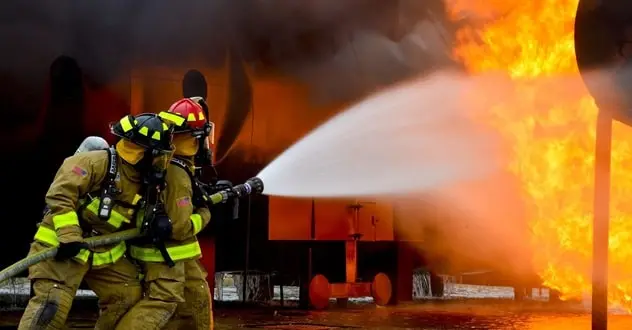So you’re a firefighter, or you work in a firehouse. You know how important it is to be prepared for any emergency that comes along. You have your gear and your tools, and you know how to use them properly. But what about the best equipment of all, the firefighting foam? What if the foam itself is causing health problems for the people who use it most?
It’s true, there’s some evidence that AFFF (aqueous film-forming foam) can cause cancer when used in certain circumstances by firefighters. In this article, we will explore the link between AFFF and cancer.
Understanding AFFF Composition
Aqueous Film-Forming Foam (AFFF) is a type of fire-suppressant foam commonly used for combating flammable liquid fires. AFFF is designed to create a thin film on the surface of the liquid, preventing the release of flammable vapors and suppressing the combustion process.
The composition of AFFF typically includes several key components:
- Surfactants: AFFF contains surfactants, which are surface-active agents that help reduce the surface tension of water. These surfactants aid in the formation of a stable foam blanket on the surface of the liquid fuel, preventing the fuel from reigniting.
- Fluorinated surfactants: Many AFFF formulations include fluorinated surfactants, such as fluorotelomers, to enhance the film-forming properties of the foam. These fluorinated compounds contribute to the effectiveness of AFFF in suppressing flammable liquid fires.
- Solvents: AFFF formulations may contain solvents to improve the mixing and flow characteristics of the foam concentrate. Common solvents include glycols or alcohols.
- Thickeners: Some AFFF formulations include thickeners to increase the viscosity of the foam. This helps improve its ability to adhere to vertical surfaces and create a stable blanket on the liquid’s surface.
- Stabilizers: Stabilizing agents are added to AFFF to prevent the breakdown of the foam over time. This helps maintain the effectiveness of the foam concentrate during storage and ensures reliable performance when needed.
- Corrosion inhibitors: AFFF formulations often include corrosion inhibitors to protect firefighting equipment and containers from corrosion, especially in the case of metal components.
- Water: The base of AFFF is water, which serves as the primary extinguishing agent. The combination of water and the aforementioned additives creates a foam that can rapidly cover the surface of flammable liquids.
These ingredients present in AFFF are the ones that cause cancers. Some of the ingredients of AFFF also include PFAS chemicals. These chemicals are known to be carcinogenic and can build toxicity in the bodies of those exposed. An NCBI study shows that PFOS is the most concentrated PFAS chemical in AFFF. It has been concluded that PFOS has led to the build-up of toxicity in Zebrafish.
Emerging Health Concerns
AFFF is a fluorinated compound, meaning it contains carbon atoms with fluorine attached. It’s used in firefighting foams to extinguish fires in airports and other industrial settings. The Environmental Protection Agency (EPA) has stated that the human health effects of exposure to AFFF are not well understood.
However, the EPA did declare that PFAS exposure can be harmful to human health. Here are the health problems EPA linked with AFFF:
- Various forms of cancer
- Reproductive effects
- Developmental effects
- Increased cholesterol levels
Besides the EPA’s findings, several other studies have also found a connection between AFFF and cancer. Studies from the Journal of Air & Waste Management and Environmental Research how PFAS exposure can result in kidney cancer, prostate cancer, and testicular cancer.
The Growing AFFF Lawsuits
Due to the increasing number of studies linking PFAS and AFFF with cancer, AFFF lawsuits are growing. According to TorHoerman Law, around 6,000 lawsuits are already consolidated into multidistrict litigation (MDL). The cases are consolidated to speed up the hearing process. This ensures quick and timely justice without any major troubles for the plaintiffs.
There are two types of AFFF lawsuits ongoing. Firstly, there are lawsuits filed by firefighters and military personnel that are directly exposed to PFAS in AFFF. Several of these people have developed cancer and they have to work with AFFF regularly. Hence, they have filed AFFF foam cancer lawsuits to seek compensation.
Secondly, government officials across the US have filed lawsuits against AFFF manufacturers over concerns about environmental contamination. The lawsuits related to AFFF primarily focus on allegations that the use of these foams has led to environmental contamination. The contaminations include groundwater and soil contamination, affecting both military and civilian sites.
PFAS compounds are known for their persistence in the environment and their potential to accumulate in human tissues. They are highly persistent. They have been found in drinking water supplies near areas where AFFF has been used extensively.
A recent article from Scientific American states that around 600 of the 9,000 PFAS chemicals are used in the US. Moreover, around 200 million Americans are exposed to PFAS chemicals, primarily PFOA and PFOS, through their tap water. Thus, people are drinking PFAS every day.
The long-term environmental impact of PFAS contamination is a growing concern, as these chemicals do not break down easily and can bioaccumulate in organisms.
Lawsuits have been filed against manufacturers of AFFF. Some of them involve claims from individuals and communities alleging health problems related to PFAS exposure. Additionally, there have been cases brought against entities, such as military bases and airports, where AFFF was used extensively.
Regulatory Responses and Industry Practices
Due to the growing concern, EPA has taken several necessary steps to regulate PFAS. For instance, in October 2023, EPA released a final rule policy, which required manufacturers to do improved reporting on the use of PFAS. Similarly, in August 2023, EPA finalized a regulation on addressing exposure to PFAS.
Additionally, $2 billion was passed in Bipartisan Infrastructure to control the emerging contaminants in drinking water. Another $1 billion was given for Bipartisan Infrastructure in June 2022.
While the EPA and FDA have taken steps to regulate PFASs, including AFFF, more needs to be done. The regulatory framework for PFASs is outdated and ineffective at protecting public health. In fact, some members of Congress have been calling for stronger regulations since 2016.
Future Directions: Research and Mitigation
The research on the effects of AFFF is still in its infancy, and more studies are needed to fully understand the risks associated. Both government agencies and corporations are working on finding alternatives to AFFF. They have found alternatives, but they come with drawbacks.
The PFAS-free AFFFs are either expensive or less effective. This means that it will take more time to get the desired alternatives. But until then, there is a need to regulate PFAS use more strictly.
Conclusion
The link between AFFF, specifically its PFAS content, and cancer is a topic of growing concern within the scientific and firefighting communities. While the evidence is still evolving, the potential risks associated with PFAS exposure underscore the importance of exploring safer alternatives.
There’s also a need to implement preventive measures to protect those who work with AFFF and the communities affected by its use. As our understanding of the hidden dangers continues to evolve, it becomes imperative to prioritize the safety of firefighters.


